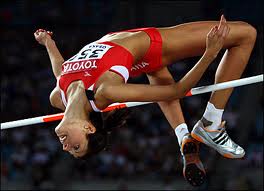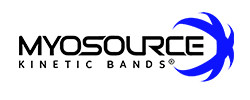Getting to a Higher Level in High JumpThe high jump is a track and field event that uses a combination of running, vertical jumping, and the ability to manipulate the body by twisting and turning. When a high jumper starts their approach, they must generate enough speed in a short distance to ignite their entire body over the bar in a controlled and timed manner. The hips must be strong for the excessive hip rotation used to go from the forward approach to over the bar head first. The Myosource Kinetic Bands are just the tool high jumpers need for adding tension to the muscles for quicker contractions, producing greater speed, and increasing jumping height. |
The Myosource Kinetic Bands will enable the high jumpers to train with consistency to create proper movements in the air, as well as work on lateral movement, build speed, and build muscle strength needed to fire quickly and powerfully. Building muscle strength will result in high jumpers becoming stronger in their takeoff, approach, and flight over the bar. The Myosource Kinetic Bands work the entire body and increase flexibility. The stronger and more flexible a high jumpers muscles are in the legs, hips, shoulders, and arms, the better their high jumps will be. A high jump is performed by utilizing a powerful arm swing, combined with foot spring, leg power, and core muscle strength to gain enough height to clear the bar. The Myosource Lower Body and Upper Body Kinetic Bands work a high jumpers entire body so that they are able to takeoff, approach, and jump with full range of motion. The Myosource Lower Body Kinetic Bands strap on above the knees, leaving the body free to practice just as they would perform. Excessive jump height is important because it gives high jumpers the time they need to manipulate their body into the proper position to get over the bar. The Myosource Kinetic Bands work all the muscles to build the strength that high jumpers need for great flexibility, speed, and strength.
Mark Your Spot - High Jump Takeoff Spot
The takeoff spot is the first thing a high jumper must master in order to begin the process of becoming successful. High jumpers must practice until they find their takeoff mark at the most convenient spot for their jump to be successful.
- High jumpers are allowed 10 steps away from the bar to mark their takeoff spot.
- High jumpers will make another mark at 5 steps away to curve towards the bar.
- High jumpers need to make adjustments to their steps away from the bar in order to perfect their takeoff. The steps must be precise or the approach will be off. Making sure that the takeoff spot is accurate takes time and adjustment. Each high jumper must find the spot that is comfortable and works best for them.

Make Your High Jump Approach What It Should Be
The approach is another vital part of the high jump skill. High jumpers must have the correct amount of steps with the adequate amount of spacing in their approach. Young or beginning high jumpers must spend the appropriate amount of time mastering the approach and finding their takeoff spot before they are able to actually jump. When a high jumper develops consistency in their takeoff and approach they are able to properly learn their jumping form and technique.
- High jumpers begin slowly and increase speed with each step. Acceleration creates the momentum needed when the high jumper reaches the bar.
- Right before the high jumper reaches their mark, which is about 5 steps away, they must slightly turn their foot inward.
- Once the high jumper gets into their curve at about step 6, their driving foot must be in front of the other.
- High jumpers will lean outward, away from the bar. This is the time when speed needs to be built up the most because the high jumper is approaching the bar.
- High jumpers must keep their eyes over the bar during their final steps before they leave the ground. Make sure to continue to lean away from the bar while proceeding to approach.
High Jump Past the Competition
Many inexperienced athletes tend to want to jump from the center point of the bar in order to leave room on each side, which is a mistake. Jumping from one side with the momentum built up gets the high jumper’s body from the side to the center of the bar. Jumping from the center does not leave the jumper enough room to clear the bar.
- High jumpers will place their planted takeoff foot in front. This foot will be the one on the outside, farthest from the bar.
- High jumpers will swing their other leg and arms upward. Some high jumpers lead with both arms, while others only use one.
- High jumpers need to get the hip and thigh of the elevated leg level with the ground, while driving the arms overhead.
- The takeoff leg of the high jumper continues rising as the jumper leaves the ground. High jumpers must be able to master their vertical jump in order to get the air they need to clear the bar.
- High jumpers will continue to lean away from the bar, arching their back as they jump up.
- High jumpers must remember their momentum is a key factor for taking them over the bar.
- Since the jumpers head is what goes over the bar first, it is important to lean the head back so the shoulders clear the bar and the back arches.
- A strong and flexible back is needed for high jumpers. As a high jumper is going over the bar they must arch their back while rotating shoulders, hips, and legs.



